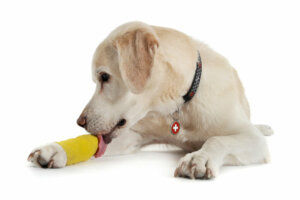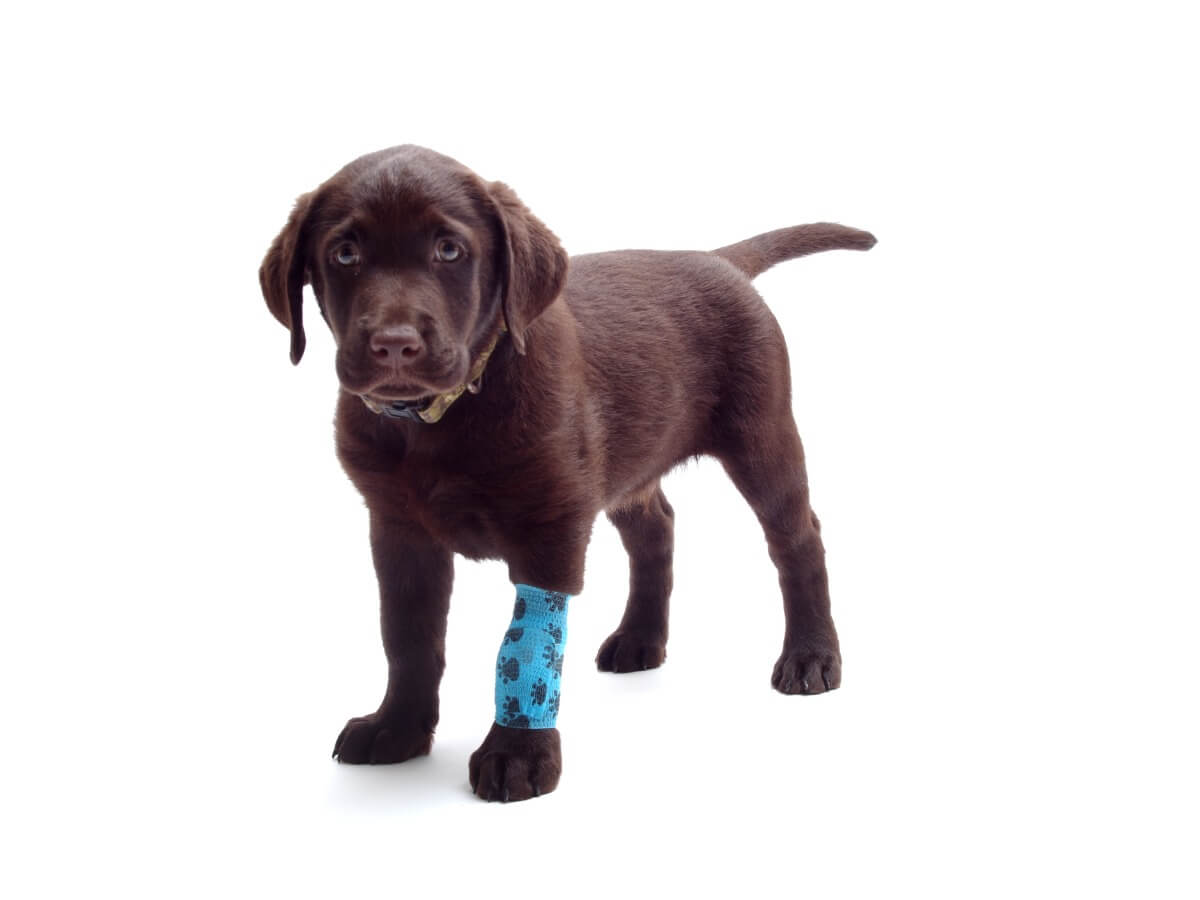Sprains in Dogs: Causes, Symptoms and Treatment


Written and verified by the vet Daniel Aguilar
Most dogs are energetic animals, who love to play with people and dogs alike. Some are so restless that they can easily have an accident and get injured. For this reason, sprains in dogs are a common reason to visit the veterinary clinic or hospital.
In this article, we’ll talk about everything you need to know about sprains in dogs, how to identify them in time and how to treat them to avoid complications. Read on to find out.
What is a sprain?
Surely you have heard about the ligaments and joints, because that is exactly where you can get a sprain. In both humans and dogs, a sprain is caused by the stretching, tearing, or rupture of a ligament.
The main function of the ligaments is to hold the bones together in the joint. Depending on the force of the pull, or the rupture of the ligaments involved, the sprain can vary in severity. As a result, the recovery time will also vary.
Causes of sprains in dogs
There are numerous reasons why your dog can injure itself and sprain a part of its body. However, most of them are considered traumatic in origin. Accidents can occur any day and in any dog. However, hunting, sporting dogs, and those that aren’t supervised when walking are the most at risk.
The main causes of a sprain in dogs are the following:
- Fights or rough play with other dogs
- Accidents
- A hard impact when jumping
- Excess weight
- Of degenerative origin, especially in geriatric patients.

Symptoms of sprains in dogs
As in any situation or illness your dog goes through, observation will always be very important with a sprain. Whenever you notice any strange behavior in the home, take note and notify your veterinarian. Pay attention, as below we’ll list the main symptoms in a sprain in dogs:
- Joint swelling – may be hot and flushed
- Lameness – in the case of affected limbs
- Excessive licking of the injured region
- Loss of appetite
- Pain and whining
Types of sprains in dogs
A sprain can occur anywhere on your pet’s body – where ligaments are found. The main regions that are often injured are the legs, knees, hips, cervical area, and neck.
Also, sprains in dogs can be classified according to their intensity. As the level increases, the greater the severity. We’ll explain it to you below:
- Level 1 sprain: This is a minor injury, in which the ligaments have been minimally torn. Here you can observe your dog with a slight discomfort when walking.
- Level 2 sprain: Within the affected joint, ligaments and muscle fibers are torn. The symptoms that your pet may exhibit will be pain, a noticeable inflammation, and greater discomfort.
- Level 3 sprain: This is the most serious sprain, usually caused by very intense trauma. Ligaments and some bones are completely broken, affecting the entire joint.
How to diagnose a sprain in dogs?
When it comes to muscle, bone, and joint injuries, professional medical evaluation is imperative. As a first step, the veterinarian will perform a general physical examination along with an orthopedic examination of your pet. Sometimes, the use of imaging methods will also be necessary to ensure the final diagnosis.
Because they’re lesions that cause pain, it’s likely that a tranquilizer will be administered to the patient, in order to facilitate their management. Once controlled, you can continue with the examination. X-rays will be one of the main support tools in obtaining clearer images of the injury.
As a result of a sprain in dogs, the tissues will be damaged. Therefore, in some cases, a physical examination won’t be sufficient to verify the extent of the injury. The use of more specialized diagnostic methods such as an ultrasound or MRI may also be suggested by the veterinarian.
Duration and treatment of sprains in dogs
How long it takes for your pet to fully recover after a sprain will depend on the level of the injury. We recommend that you follow the instructions and recommendations to the letter, so that you don’t prolong your dog’s discomfort.
The indicated treatment for a sprain in dogs is mainly based on the following points:
- Use of drugs: The administration of analgesics and anti-inflammatories will be essential in order to reduce your pet’s discomfort. Both the route of administration and the dose will be indicated by the veterinarian.
- Immobilization: It’s difficult to get the dog to fully obey your instructions. Therefore, the use of splints and bandages can help immobilize the joint. Make sure you keep it clean and dry. If necessary, very carefully you can periodically change the bandage and the material that was used.
- Absolute rest: Reducing the movements in their entirety will favor the recovery of the ligaments and the joint in general. Provides a comfortable space for your canid to rest. If it lives with other dogs, keep them under observation, to prevent them from hurting the patient by playing with them.
- Surgery: In very severe cases of sprains in dogs, surgery may be necessary to rebuild the joint.
- Rehabilitation: Regardless of the level of sprain your pet has suffered, the veterinarian may recommend techniques such as hydrotherapy, massage, laser and electricity. The objective will be to reduce the probability of sequelae and improve the patient’s quality of life.

The use of nutritional supplements that promote good body condition and good weight control will be effective in preventing a sprain from occurring in dogs. An accident can happen at any time, so if you suspect an injury, consult your veterinarian.
Most dogs are energetic animals, who love to play with people and dogs alike. Some are so restless that they can easily have an accident and get injured. For this reason, sprains in dogs are a common reason to visit the veterinary clinic or hospital.
In this article, we’ll talk about everything you need to know about sprains in dogs, how to identify them in time and how to treat them to avoid complications. Read on to find out.
What is a sprain?
Surely you have heard about the ligaments and joints, because that is exactly where you can get a sprain. In both humans and dogs, a sprain is caused by the stretching, tearing, or rupture of a ligament.
The main function of the ligaments is to hold the bones together in the joint. Depending on the force of the pull, or the rupture of the ligaments involved, the sprain can vary in severity. As a result, the recovery time will also vary.
Causes of sprains in dogs
There are numerous reasons why your dog can injure itself and sprain a part of its body. However, most of them are considered traumatic in origin. Accidents can occur any day and in any dog. However, hunting, sporting dogs, and those that aren’t supervised when walking are the most at risk.
The main causes of a sprain in dogs are the following:
- Fights or rough play with other dogs
- Accidents
- A hard impact when jumping
- Excess weight
- Of degenerative origin, especially in geriatric patients.

Symptoms of sprains in dogs
As in any situation or illness your dog goes through, observation will always be very important with a sprain. Whenever you notice any strange behavior in the home, take note and notify your veterinarian. Pay attention, as below we’ll list the main symptoms in a sprain in dogs:
- Joint swelling – may be hot and flushed
- Lameness – in the case of affected limbs
- Excessive licking of the injured region
- Loss of appetite
- Pain and whining
Types of sprains in dogs
A sprain can occur anywhere on your pet’s body – where ligaments are found. The main regions that are often injured are the legs, knees, hips, cervical area, and neck.
Also, sprains in dogs can be classified according to their intensity. As the level increases, the greater the severity. We’ll explain it to you below:
- Level 1 sprain: This is a minor injury, in which the ligaments have been minimally torn. Here you can observe your dog with a slight discomfort when walking.
- Level 2 sprain: Within the affected joint, ligaments and muscle fibers are torn. The symptoms that your pet may exhibit will be pain, a noticeable inflammation, and greater discomfort.
- Level 3 sprain: This is the most serious sprain, usually caused by very intense trauma. Ligaments and some bones are completely broken, affecting the entire joint.
How to diagnose a sprain in dogs?
When it comes to muscle, bone, and joint injuries, professional medical evaluation is imperative. As a first step, the veterinarian will perform a general physical examination along with an orthopedic examination of your pet. Sometimes, the use of imaging methods will also be necessary to ensure the final diagnosis.
Because they’re lesions that cause pain, it’s likely that a tranquilizer will be administered to the patient, in order to facilitate their management. Once controlled, you can continue with the examination. X-rays will be one of the main support tools in obtaining clearer images of the injury.
As a result of a sprain in dogs, the tissues will be damaged. Therefore, in some cases, a physical examination won’t be sufficient to verify the extent of the injury. The use of more specialized diagnostic methods such as an ultrasound or MRI may also be suggested by the veterinarian.
Duration and treatment of sprains in dogs
How long it takes for your pet to fully recover after a sprain will depend on the level of the injury. We recommend that you follow the instructions and recommendations to the letter, so that you don’t prolong your dog’s discomfort.
The indicated treatment for a sprain in dogs is mainly based on the following points:
- Use of drugs: The administration of analgesics and anti-inflammatories will be essential in order to reduce your pet’s discomfort. Both the route of administration and the dose will be indicated by the veterinarian.
- Immobilization: It’s difficult to get the dog to fully obey your instructions. Therefore, the use of splints and bandages can help immobilize the joint. Make sure you keep it clean and dry. If necessary, very carefully you can periodically change the bandage and the material that was used.
- Absolute rest: Reducing the movements in their entirety will favor the recovery of the ligaments and the joint in general. Provides a comfortable space for your canid to rest. If it lives with other dogs, keep them under observation, to prevent them from hurting the patient by playing with them.
- Surgery: In very severe cases of sprains in dogs, surgery may be necessary to rebuild the joint.
- Rehabilitation: Regardless of the level of sprain your pet has suffered, the veterinarian may recommend techniques such as hydrotherapy, massage, laser and electricity. The objective will be to reduce the probability of sequelae and improve the patient’s quality of life.

The use of nutritional supplements that promote good body condition and good weight control will be effective in preventing a sprain from occurring in dogs. An accident can happen at any time, so if you suspect an injury, consult your veterinarian.
All cited sources were thoroughly reviewed by our team to ensure their quality, reliability, currency, and validity. The bibliography of this article was considered reliable and of academic or scientific accuracy.
Fischer C. Ruptura del ligamento cruzado craneal en perros. Chile, 2014. Consultado el 02 de junio de 2021. Disponible en: file:///C:/Users/danma/Downloads/Dialnet-RuptureOfTheCranialCruciateLigamentInDogs-5450412.pdf
Medina S. Esguince en perros – Causas, síntomas y tratamiento. España. Publicado el 03 de diciembre de 2019. Consultado el 02 de junio de 2021. Disponible en: https://www.expertoanimal.com/esguince-en-perros-causas-sintomas-y-tratamiento-24618.html
Saadoun A. ¿Qué hacer si mi perro tiene un esguince? Barcelona, España. Consultado el 02 de junio de 2021. Disponible en: https://www.dogsplanet.com/es/salud/esguince-perro/
¿Cómo curar el esguince en perros? Madrid, España. Consultado el 02 de junio de 2021. Disponible en: https://blog.mascotaysalud.com/2018/12/18/como-curar-esguince-patas-perros/
Spragley R. Como tratar un esguince en un perro. California, Estados Unidos. Consultado el 02 de junio de 2021. Disponible en: https://es.wikihow.com/tratar-un-esguince-en-un-perro
Esguince canino, causas, síntomas, tratamientos, prevención y más. Estados Unidos. Consultado el 02 de junio de 2021. Disponible en: https://www.mascotarey.com/perros/salud/esguince-canino/
Amieva D. Manual de rehabilitación y fisioterapia del miembro pelviano en perros (con pérdida de masa muscular). Estado de México. Consultado el 04 de junio de 2021. Disponibl en: https://core.ac.uk/download/pdf/80533757.pdf
This text is provided for informational purposes only and does not replace consultation with a professional. If in doubt, consult your specialist.








